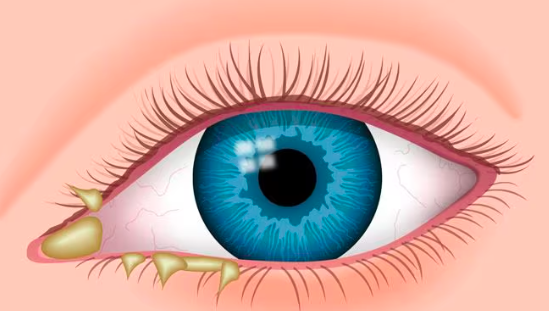It’s a morning ritual we all know: rubbing that crusty, yellowish stuff out of the corners of your eyes before you even make it to the bathroom mirror. You’ve probably called it “sleep,” “eye boogers,” or maybe “eye crust”—but have you ever wondered what it actually is?
As it turns out, this gunky substance is way more than just an annoyance—it’s a fascinating little sign that your eyes have been working hard while you sleep. Thanks to viral insights from neuroscientist Andrew Huberman and other leading experts, we now know that your morning eye gunk is a snapshot of your eye’s overnight cleaning crew in action.
So… What Is That Stuff?
That crusty substance is a combo of:
- Mucus, which traps dust and debris
- Oils, from glands in your eyelids that keep your tears from drying up
- Tears, which help flush out irritants
- Dead skin cells, naturally shed overnight
- Bacteria—and the aftermath of your immune system fighting them off
Yep, your eyes are battling microbes while you sleep, and that gunk? It’s basically the war zone cleanup.
Dr. Rachel Clemmons, an ophthalmologist at Wills Eye Hospital, puts it simply: “What you’re seeing in the morning is proof that your eyes were hard at work protecting themselves all night long.”
Your Eyes Never Sleep—Even When You Do
When you’re awake, blinking keeps your eyes clean. But during sleep, you’re not blinking, so your body shifts into maintenance mode. Your tear film steps in to fight germs, hydrate, and flush out junk—like a tiny sanitation team for your eyes.
That yellow crust forms because:
- Tear evaporation leaves a concentrated residue
- Mucus and oil mix with dead cells and bacteria
- The whole mixture dries overnight into that signature crust
Dr. Elizabeth Chen, a microbiologist, calls it “ocular housekeeping.” It’s your immune system quietly doing its job.
When Eye Gunk Isn’t Normal
Most of the time, morning eye crust is completely normal. But here’s what to watch for:
- Thick, green, or gray discharge → Could mean infection
- Watery, sticky, or rope-like strings → Might be allergies or dry eye
- Blood in discharge → Seek medical help right away
- Discharge all day long → Time to get your eyes checked
According to Dr. Samantha Weiss, any sudden change in how much or what kind of discharge you’re seeing is worth paying attention to.
Your Eyes Have Their Own Ecosystem—Seriously
Just like your gut has good bacteria, your eyes host a community of microorganisms that help keep them healthy. This delicate balance helps fend off invaders. But if more aggressive bacteria—like Staph aureus or Pseudomonas—start taking over, you could be at risk for infection.
Fortunately, your tears are loaded with mini superheroes like:
- Lysozyme (breaks down bacterial walls)
- Lactoferrin (starves bacteria of iron)
- Secretory IgA (neutralizes invaders)
- Defensins (basically antimicrobial ninjas)
Why Some People Get More Eye Gunk Than Others
A few reasons:
- Babies: Narrow tear ducts = more crust
- Older adults: Tear changes and dry eye
- Dry environments: Tear film evaporates faster
- Allergies or pollution: Eyes produce more mucus to defend themselves
- Contact lens wearers: More likely to have buildup if lenses aren’t cleaned properly
- Staring at screens: Less blinking = less cleaning
Even how well you sleep matters—if you sleep with your eyes slightly open (yes, that’s a thing), you might wake up with more crust.
When to Be Concerned
Call your doctor if you notice:
- Green/yellow pus-like discharge
- Red, painful, or swollen eyes
- Blurred vision or light sensitivity
- Discharge that doesn’t stop after you wake up
Conditions like conjunctivitis (pink eye), keratitis, or tear duct infections could be behind it—and they can get serious if ignored.
How to Deal with Eye Discharge the Right Way
1. Gently clean your eyes in the morning
Use a clean, warm washcloth. Wipe from the inner corner outward. Don’t rub too hard!
2. Use warm compresses
Helps loosen stubborn gunk—great for blepharitis or dry eye.
3. Keep your hands clean
Dirty hands = bacteria near your eyes.
4. Replace makeup regularly
Especially mascara and eyeliner. They’re bacteria magnets.
5. Follow contact lens hygiene
Clean them properly and avoid sleeping in them (unless prescribed).
6. Consider artificial tears or eyelid wipes
These can help if you have dry eye, allergies, or blepharitis.
The Cool Science on the Horizon
Researchers are exploring things like:
- Probiotic eye treatments to balance the eye’s microbiome
- Tear protein analysis to diagnose diseases
- Moisture chambers to protect eyes overnight
- Antimicrobial peptides as future infection fighters
As Dr. Rachel Caspi of the National Eye Institute notes, “We’re learning that your eye discharge can tell us a lot about your health—not just your eyes, but your whole body.”
Bottom Line: That Morning Eye Gunk Isn’t Gross—It’s Your Body Doing Its Job
What seems like an everyday annoyance is actually your immune system quietly keeping your eyes safe. So next time you wake up and reach for the washcloth, give your body a little credit—it’s been pulling an all-nighter to keep you healthy.

Sophia Reynolds is a dedicated journalist and a key contributor to Storyoftheday24.com. With a passion for uncovering compelling stories, Sophia Reynolds delivers insightful, well-researched news across various categories. Known for breaking down complex topics into engaging and accessible content, Sophia Reynolds has built a reputation for accuracy and reliability. With years of experience in the media industry, Sophia Reynolds remains committed to providing readers with timely and trustworthy news, making them a respected voice in modern journalism.
